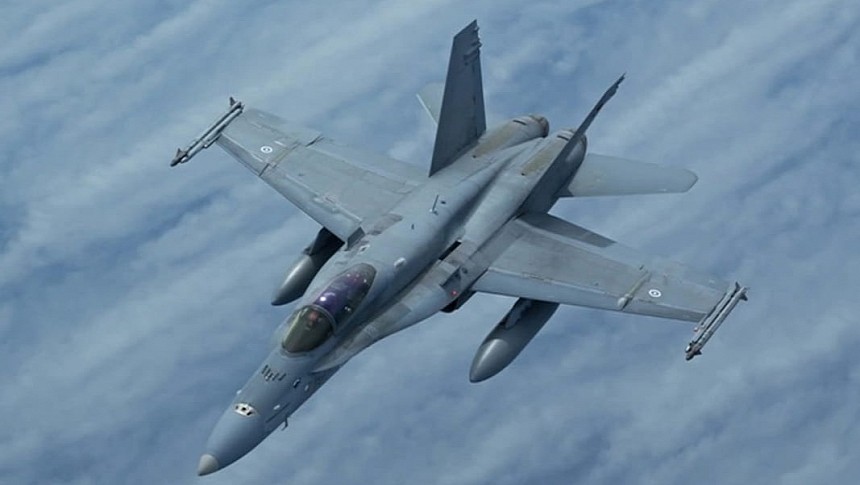The F/A-18 E/F Super Hornet is presently one of the U.S. Navy's main aerial platforms. Deployed in service as a replacement for the legendary Grumman F-14 Tomcat in the late 1990s, it also begins to grow old, not as a general platform, but at least as far as some of the systems it packs go.
The plane has been for a while at the center of the American military's modernization efforts. Most recently, meaning just a month or so ago, we learned of the aircraft getting a new mighty weapon in its arsenal, the Raytheon-made air-launched precision-guided bomb called StormBreaker.
The bomb joins an already formidable arsenal that also includes a 20 mm cannon, Sidewinder missiles, Sparrows, Harpoons, Mavericks, but also Joint Stand-Off Weapons and Joint Direct Attack Munitions, among others.
The punch the Super Hornet packs is thus impressive, but it can only be delivered properly if the aircraft is capable of surviving the ever-evolving threats of today's battlefields. And it can only do that if it has a more modern and more capable electronic warfare system.
And that's exactly what the plane is going to get after the U.S. Navy handed defense contractor Raytheon an $80 million contract to prototype something called the ADVEW. That's short for Advanced Electronic Warfare.
At the time of writing the Super Hornets use an integrated defensive electronic countermeasure system called AN/ALQ-214 and a radar warning receiver named AN/ALR-67(V)3 to detect threats and defend themselves.
If approved by the Navy, the ADVEW will replace both of them in a single move, because it has been imagined as a one-box solution. It's meant to be the last one to ever be fitted on the Super Hornet, especially considering how the plane's maker, Boeing, will stop rolling it off the assembly lines in 2025.
The details of the system have not been made public, in part because the thing does not exist yet. We do know it will use a lot fewer components than the current systems, and that it will be built using government-defined open architecture to make it adaptable as technologies progress.
Raytheon will work on the Super Hornet at its facility in Goleta, California. Over the next 36 months or so the ADVEW will have to burn through preliminary design review, critical design review, and finally flight testing.
The F/A-18 Super Hornet is powered by a pair of engines capable of developing 22,000 pounds lbs of thrust each, pushing the aircraft to a top speed of Mach 1.8 (1,381 mph/2,222 kph).
A little over 600 of these planes were made, many of them deployed in the service of the American military, but with other countries in the world, like Australia and Kuwait, using them too.
The bomb joins an already formidable arsenal that also includes a 20 mm cannon, Sidewinder missiles, Sparrows, Harpoons, Mavericks, but also Joint Stand-Off Weapons and Joint Direct Attack Munitions, among others.
The punch the Super Hornet packs is thus impressive, but it can only be delivered properly if the aircraft is capable of surviving the ever-evolving threats of today's battlefields. And it can only do that if it has a more modern and more capable electronic warfare system.
And that's exactly what the plane is going to get after the U.S. Navy handed defense contractor Raytheon an $80 million contract to prototype something called the ADVEW. That's short for Advanced Electronic Warfare.
At the time of writing the Super Hornets use an integrated defensive electronic countermeasure system called AN/ALQ-214 and a radar warning receiver named AN/ALR-67(V)3 to detect threats and defend themselves.
If approved by the Navy, the ADVEW will replace both of them in a single move, because it has been imagined as a one-box solution. It's meant to be the last one to ever be fitted on the Super Hornet, especially considering how the plane's maker, Boeing, will stop rolling it off the assembly lines in 2025.
The details of the system have not been made public, in part because the thing does not exist yet. We do know it will use a lot fewer components than the current systems, and that it will be built using government-defined open architecture to make it adaptable as technologies progress.
Raytheon will work on the Super Hornet at its facility in Goleta, California. Over the next 36 months or so the ADVEW will have to burn through preliminary design review, critical design review, and finally flight testing.
The F/A-18 Super Hornet is powered by a pair of engines capable of developing 22,000 pounds lbs of thrust each, pushing the aircraft to a top speed of Mach 1.8 (1,381 mph/2,222 kph).
A little over 600 of these planes were made, many of them deployed in the service of the American military, but with other countries in the world, like Australia and Kuwait, using them too.










